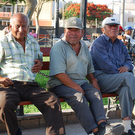New Response Type May Help Determine Multiple Myeloma Patients’ Prognoses

Results from a recent clinical study suggest that a new type of response, called an immunophenotypic response, strongly predicts disease progression in elderly multiple myeloma patients. Patients who achieved an immunophenotypic response had superior progression-free survival than patients who achieved a complete response or stringent complete response.
The authors suggested that testing for these three types of responses provides complementary information and that effort should be made to refine response criteria for multiple myeloma.
A number of previous studies have shown that achieving a complete response, which is defined by no detectable monoclonal protein and less than five percent of plasma cells in the bone marrow, is associated with extended survival.
More recently, researchers have questioned the sensitivity of the response criteria for disease response. A more stringent definition of complete response requires a normal free light chain ratio, in addition to the standard criteria for a complete response. Achievement of a stringent complete response may be determined using a free light chain assay. However, due to limited data on stringent complete response, its prognostic value has not been confirmed.
As a result, researchers are currently investigating the prognostic impact of a third type of response, called an immunophenotypic response. A technique called multiparameter flow cytometry can be used to determine whether a patient has achieved an immunophenotypic response. The technique identifies the proteins present on a cell’s surface in order to discriminate between normal plasma cells and myeloma plasma cells.
Prior research has suggested that immunophenotypic response is a prognostic factor for myeloma. However, the studies were conducted in a small population of transplant-eligible patients before the introduction of novel agents.
In the current study, a group of Spanish researchers aimed to evaluate and compare the prognostic values of complete response, stringent complete response, and immunophenotypic response.
Researchers randomly assigned 260 elderly myeloma patients to receive six cycles of induction therapy with Velcade (bortezomib), melphalan (Alkeran), and prednisone (abbreviated as VMP) or Velcade, thalidomide (Thalomid), and prednisone (abbreviated as VTP).
After induction therapy, 102 patients achieved at least a partial response and had blood samples available for the serum free light chain assay. They were then assessed for all three different response types.
Among the 102 patients with at least a partial response, 43 percent achieved a complete response, 30 percent achieved a stringent complete response, and 30 percent achieved an immunophenotypic response.
The researchers found that the better the patient response, the longer the progression-free survival. After three years, progression-free survival was 90 percent for those achieving an immunophenotypic response, 69 percent for stringent complete response, 60 percent for complete response, and 35 percent for partial response.
There was also a trend toward longer overall survival. After three years, overall survival was 94 percent for those achieving an immunophenotypic response, 94 percent for stringent complete response, 93 percent for complete response, and 70 percent for partial response.
For more information, please see the study in the Journal of Clinical Oncology (abstract).
Related Articles:
- None Found

I found this article helpful and would like to be included on your email articles.
Thanks,
Sue McDevitt
I like the new look of the website.
Thanks for the feedback, John. We're happy with the new design, as well. We hope, though, that we'll be able to implement additional improvements to the site over the next few months.
Progress toward fundraising goal
for all of 2020:
15%
For more information, see the Beacon's
"2020 Fundraising: Goals And Updates" page